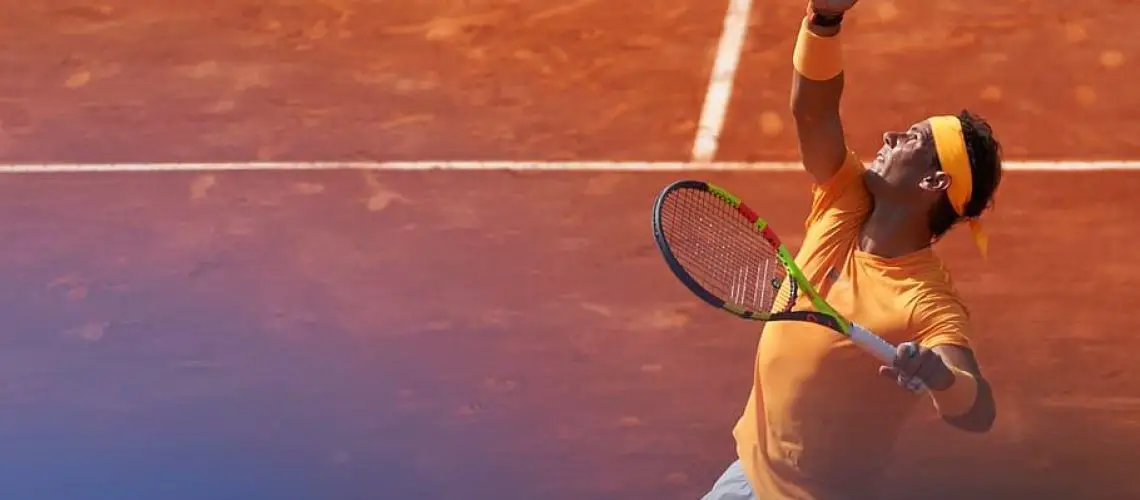We may earn money or products from the companies mentioned in this post.
A Brief Overview of Tennis Balls

Tennis balls have come a long way since their inception, evolving from simple leather pouches filled with hair to the high-performance spheres we see on the courts today The history of tennis balls dates back to the 12th century when players used balls made of wool or cloth In the 19th century, they transitioned to using rubber as the core material, which revolutionized the game
The importance of tennis balls in the game cannot be overstated They are an integral part of every match, dictating the pace and trajectory of each shot Tennis balls not only provide a consistent bounce but also allow players to achieve spin and control over their shots Without them, tennis would be an entirely different sport
Purpose of This Article

In this article, we will delve into the materials used in making tennis balls and explore common questions related to their composition Understanding what goes into creating these seemingly simple objects can enhance our appreciation for the craftsmanship and engineering that goes behind them
We will uncover fascinating details about how tennis balls are manufactured, shedding light on why they perform the way they do on different court surfaces Whether you’re a casual player or a passionate fan, this article aims to provide you with valuable insights about one of tennis’ most essential components
Tennis Ball Materials

Core Components
When it comes to tennis ball materials, the core components play a crucial role in determining the performance and durability of the ball The two main components of the core are the rubber material and the pressurized air or gas inside
1 Rubber Material
The rubber material used in tennis balls can vary, with options including natural rubber, synthetic rubber, or a combination of both Each type of rubber brings its own unique characteristics to the ball
Natural rubber offers excellent elasticity and responsiveness, resulting in a lively bounce that adds excitement to each shot On the other hand, synthetic rubber provides enhanced durability, ensuring that tennis balls can withstand rigorous gameplay without wearing out quickly
i) Bounce Characteristics
The choice of rubber material directly influences the bounce characteristics of a tennis ball Natural rubber tends to provide a higher and more dynamic bounce, while synthetic rubber offers a slightly lower but consistent bounce throughout extended play sessions
ii) Durability and Air Retention
Durability is another important aspect when considering tennis ball materials Synthetic rubber is known for its ability to withstand frequent use on various court surfaces without losing its shape or deteriorating quickly
Air retention is also crucial for maintaining optimal performance during gameplay Both natural and synthetic rubbers have properties that help retain pressurized air within the core, ensuring that tennis balls maintain their desired level of firmness and bounce over time
2 Pressurized Air or Gas Inside the Core
In addition to the rubber material used in tennis balls, there is also pressurized air or gas inside their cores This internal pressure greatly impacts how they perform on the court
The most common gas used in tennis ball cores is air, but some manufacturers also use nitrogen to enhance performance The choice of gas can vary depending on the desired characteristics and preferences of players
i) Type of Gas Used
Air is the traditional choice for pressurizing tennis balls It provides a responsive and predictable bounce, allowing players to have better control over their shots However, some manufacturers opt for nitrogen as it offers superior pressure retention, resulting in a more consistent bounce throughout extended play sessions
ii) Role in Maintaining Bounce and Performance
The pressurized air or gas inside the core plays a vital role in maintaining the bounce and overall performance of tennis balls By keeping the core firm and resilient, it ensures that each shot delivers the desired level of power, speed, and accuracy
Exterior Surface Materials
While the core components are essential for a tennis ball’s performance, the exterior surface materials also play a significant role in gameplay The outer covering is typically made from felt fabric, which has specific characteristics that impact aerodynamics and spin control during play
1 Felt Fabric Covering
The felt fabric covering on tennis balls usually consists of wool, nylon, or polyester fibers tightly woven together to create a durable yet soft exterior surface
Wool felt provides excellent durability while offering good grip on different court surfaces Nylon felt is often used for recreational or practice balls due to its affordability and reasonable durability Polyester felt combines durability with enhanced resistance to abrasion for prolonged use
i) Composition
Tennis ball covers are commonly composed of either wool, nylon, or polyester fibers Each composition brings its unique qualities to the game and affects how the ball behaves during play
ii) Role in Aerodynamics and Spin Control During Play
The felt fabric covering on tennis balls plays a crucial role in aerodynamics and spin control The texture of the felt interacts with the air as the ball travels, influencing its flight path and allowing players to generate different amounts of spin
When a player applies topspin or backspin to the ball, the felt material grips the court surface, enabling increased control over shot trajectory Moreover, variations in the felt’s texture can affect how much grip is achieved, further impacting spin generation and shot versatility
Tennis Ball Manufacturing Process

Have you ever wondered how tennis balls are made? Let’s dive into the fascinating process of creating these iconic sports accessories From the rubber core to the felt covering, each step is crucial in ensuring a high-quality and consistent product Let’s explore the steps involved in the production of tennis balls
Rubber Core Creation
The first step in making a tennis ball is creating the rubber core, which provides its essential bounce and durability It all starts with mixing raw materials to create a specialized rubber compound This mixture undergoes a meticulous molding process, forming two half-shells that will eventually come together to form the final sphere The half-shells are then cured using heat, resulting in optimal shape and bounce characteristics
Bonding Two Half-Shells Together
Now that we have our perfectly molded half-shells, it’s time to bring them together Using precise techniques and adhesives, the two halves are bonded firmly, creating a solid sphere that will soon become a tennis ball This bonding process ensures that the ball remains intact during intense gameplay
Insertion of Pressurized Gas
Next comes an interesting step: inserting pressurized gas into the completed core The gas helps maintain consistent pressure within the ball, contributing to its lively bounce on various surfaces This essential step ensures that every tennis ball meets strict standards for performance and playability
Attaching Felt Fabric Covering
The final step involves attaching a felt fabric covering to the exterior surface of the rubber core To achieve this, pieces of felt are precisely cut to size and then securely glued onto the rubber core using specialized adhesives The felt not only provides grip but also enhances visibility for players on the court
And there you have it! The tennis ball manufacturing process is a delicate blend of science and craftsmanship, resulting in the perfect sports accessory From the creation of the rubber core to the attachment of the felt fabric covering, every step plays a crucial role in producing high-quality tennis balls that are loved by players around the world
Frequently Asked Questions About Tennis Balls

Why are tennis balls pressurized?
Tennis balls are pressurized to enhance their performance on the court The internal pressure plays a crucial role in how the ball bounces and reacts to different shots Pressurized tennis balls have a hollow core filled with air, which creates a lively bounce when struck This allows players to generate more power and spin during gameplay
On the other hand, non-pressurized or pressureless tennis balls do not contain air-filled cores Instead, they rely on solid rubber construction for durability and consistency While they may not provide the same level of bounce as pressurized balls, they have longer lifespans and are often used for training purposes or in situations where consistent bounce is preferred over added power
How long do tennis balls last?
The lifespan of tennis balls can vary depending on several factors Playing conditions such as court surface, temperature, and humidity can affect how quickly the balls wear out Hard courts tend to be more abrasive compared to clay or grass courts, which can shorten the lifespan of tennis balls
Additionally, the frequency and intensity of use also play a role in how long tennis balls last Regular players who hit with greater force may find that their balls lose their bounce faster than occasional recreational players
Signs that it’s time to replace your tennis balls include decreased bounce height and less felt covering on the ball’s surface Once these signs become noticeable during gameplay, it’s a good indication that it’s time for new tennis balls
Why are tennis balls yellow or fluorescent green?
The color choice of tennis balls has an interesting history behind it Traditionally, white was the standard color for tennis balls However, during televised matches, it was challenging for viewers to see the white balls against the bright background of the court
In response to this visibility issue, tennis ball manufacturers introduced the vibrant colors of yellow and fluorescent green These colors provide a high level of contrast against various court surfaces, making it easier for players and spectators to track the ball’s movement during play
Today, yellow is the most commonly used color for professional tennis balls, while fluorescent green is often seen in recreational or training balls
By SEOCONTENTMASTER
Useful Links

How are Tennis Balls Made?
How a tennis ball is made
Are Tennis Ball Felt Made Out Of
The Evolution of the Tennis Ball
How It’s Made: Tennis Balls
What Are Tennis Balls Made of? – Material, Size & Weight
How Tennis Balls are Made? [DETAILED EXPLANATION]
The history of tennis balls
Why tennis balls are yellow — or maybe green
What’s Inside A Tennis Ball?
History of the Tennis Ball
How tennis balls are made: inside Wilson’s tennis-ball factory
New Balls, Please
How to Make a Tennis Ball
How to Choose the Right Tennis Balls
Tennis Balls: Everything You Need to Know about Them
Tennis Ball Types » TennisReboot
The History of the Tennis Ball






